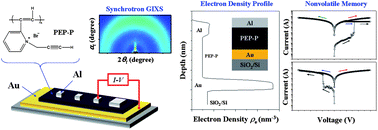Electrically permanent memory characteristics of an ionic conjugated polymer
Abstract
In this work, an ionic

* Corresponding authors
a
Department of Chemistry, Division of Advanced Materials Science, Center for Electro-Photo Behaviors in Advanced Molecular Systems, Pohang Accelerator Laboratory, Polymer Research Institute, and BK School of Molecular Science, Pohang University of Science & Technology, Pohang 790-784, Republic of Korea
E-mail:
ree@postech.edu
Fax: +82-54-279-3399
Tel: +82-54-279-2120
b
Polymer Chemistry Laboratory, College of General Education, Kyungil University, Hayang, Kyungsangbuk-do 712-701, Republic of Korea
E-mail:
ysgal@bear.kyungil.ac.kr
Tel: +82-53-850-7115
In this work, an ionic

 Please wait while we load your content...
Something went wrong. Try again?
Please wait while we load your content...
Something went wrong. Try again?
Y. Ko, W. Kwon, D. M. Kim, K. Kim, Y. Gal and M. Ree, Polym. Chem., 2012, 3, 2028 DOI: 10.1039/C2PY20129A
To request permission to reproduce material from this article, please go to the Copyright Clearance Center request page.
If you are an author contributing to an RSC publication, you do not need to request permission provided correct acknowledgement is given.
If you are the author of this article, you do not need to request permission to reproduce figures and diagrams provided correct acknowledgement is given. If you want to reproduce the whole article in a third-party publication (excluding your thesis/dissertation for which permission is not required) please go to the Copyright Clearance Center request page.
Read more about how to correctly acknowledge RSC content.
 Fetching data from CrossRef.
Fetching data from CrossRef.
This may take some time to load.
Loading related content
